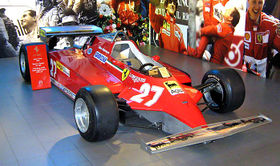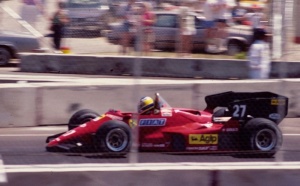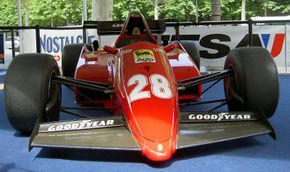Ferrari 126 C

| |
| Ferrari 126C | |
|---|---|
| Category | Formula One |
| Constructor | Scuderia Ferrari |
| Designer | Mauro Forghieri Harvey Postlethwaite |
| Team | Scuderia Ferrari |
| Drivers | 27. Gilles Villeneuve, Patrick Tambay, Michele Alboreto 28. Didier Pironi, Mario Andretti, René Arnoux |
| Chassis | carbon-fibre and aluminium honeycomb composite monocoque structure |
| Front suspension | Double wishbone, inboard spring/damper. |
| Rear suspension | Double wishbone suspension |
| Engine name | Ferrari Tipo021,031 |
| Capacity | 1500cc |
| Configuration | 120-degree V6, |
| Turbo/NA | turbo, |
| Engine position | mid-engine, longitudinally mounted |
| Gearbox name | |
| Gears | 6-speed sequential transverse gearbox |
| Type | manual |
| Differential | |
| Fuel | Agip |
| Tires | Goodyear |
| Debut | 1981 Argentine Grand Prix |
| Races | 59 |
| Wins | 10 |
| Cons champ | 2 (1982,1983) |
| Drivers champ | 0 |
| Poles | 10 |
| Fastest laps | 12 |
| Video | This is the same car Renè Arnoux drove his last fast lap in an F1 race at the Dutch Grand Prix |
The Ferrari 126C was the car with which Ferrari raced in the 1982 Formula One season. It was the team's first attempt at a turbo engined Formula 1 car. It was designed by Mauro Forghieri and Harvey Postlethwaite and used between the 1981 and 1984 seasons.
Development and race history
The 126C was designed to replace the now obsolete 312T series in use since 1975. The basic chassis was almost identical but the smaller V6 turbo engine suited the ground effect aerodynamics and was a better package overall. The engine was fitted with twin KKK turbochargers and produced around 600bhp in qualifying trim, detuned to 550bhp for the races proper. The car proved to be very fast but Gilles Villeneuve found the handling to be atrocious. The engine had massive turbo lag which gave way to a large power curve which upset the balance of the chassis. Combined to the hard suspension the car tended to slide around corners before the ground effect pulled the car back to the track. This had the side effects of exposing the drivers to even larger g-forces than the Williams FW07 or Brabham BT49 and the car's tendency to overuse its tyres. In all it made for a very tricky driving experience.
The car was first tested during the Italian Grand Prix in 1980. In testing it proved far faster than the 312T5 chassis the team were using and Gilles Villeneuve preferred it, although had reservations about the handling. Early unreliabity in 1981 with the turbo engine put paid to Villeneuve's championship hopes but he did score back to back victories in Monaco and Spain and several podium places. Because of the problematic handling the 126C was at it's best on fast tracks such as Hockenheim, Silverstone, Monza and the Österreichring.
With the arrival of Harvey Poselthwaite and a complete overhaul of the car in time for the 1982 season, things looked better. The turbo engine was developed and reliability was found whilst the car was redesigned around a smaller and nimbler chassis. In fact the 126C2 was Ferrari's first genuine full monocoque chassis, which improved the handling immensely. Villeneuve and Didier Pironi posted record times in testing with the 126C2 and the start of the season was promising with several solid results. Then came the infamous race at San Marino where Pironi disobeyed team orders and stole the win from Villeneuve. The fallout from the race led to Villeneuve's tragic death in an horrific accident in qualifying for the next round in Belgium, which left Pironi as team leader. Pironi himself was nearly killed in a similar accident in Germany, but this didn't stop Ferrari from winning the constructors championship that year. The 126C2 was developed during the season with new wings and bodywork tried and the engine's power boosted to 650bhp in qualifying trim and aroudn 600bhp for the races.
Mandatory flat bottoms for the cars were introduced for 1983 and the 126C3 was designed with this in mind. In place of the ground effects, Poselthwaite designed an oversized but effective rear wing which clawed back around 50% of the lost downforce, whilst the engineers boosted the power of the engine even further to compensate to around 700bhp. Patrick Tambay and René Arnoux scored four wins between them and were both in contention for the world championship throughout 1983 but late unreliability cost them both, but Ferrari took the constructors title for the second year in a row.
The 1984 season season wasn't as successful, as McLaren introduced their successful MP4/2 car, which was far more effective than the 126C4 and dominated the year. Michele Alboreto won just once and Ferrari finished as runner up in the constructors championship.
The 126C won 10 races, took 10 pole positions and scored 260.5 points.
| Ferrari Formula One cars | |||||||||||||||||||||||||||||||||||||||||
| 40s | 1950s | 1960s | 1970s | ||||||||||||||||||||||||||||||||||||||
| 8 | 9 | 0 | 1 | 2 | 3 | 4 | 5 | 6 | 7 | 8 | 9 | 0 | 1 | 2 | 3 | 4 | 5 | 6 | 7 | 8 | 9 | 0 | 1 | 2 | 3 | 4 | 5 | 6 | 7 | 8 | 9 | ||||||||||
| 125 | 275 340 375 |
500 | 553 625 |
555 D50 |
801 | 412 246 |
256 | 156 | 158 1512 |
312 | 312 B | 312 T | |||||||||||||||||||||||||||||
| 1980s | 1990s | 2000s | |||||||||||||||||||||||||||||||||||||||
| 0 | 1 | 2 | 3 | 4 | 5 | 6 | 7 | 8 | 9 | 0 | 1 | 2 | 3 | 4 | 5 | 6 | 7 | 8 | 9 | 0 | 1 | 2 | 3 | 4 | 5 | 6 | 7 | 8 | 9 | ||||||||||||
| 312 T | 126 C | 156/85 | F1/86 | F1/87 | 640 | 641 | 642/643 | F92A | F93A | 412T | F310/B | F300 | F399 | F1-2000 | F2001 | F2001 F2002 |
F2002B F2003-GA |
F2004 | F2004M F2005 |
248 | F2007 | ||||||||||||||||||||

